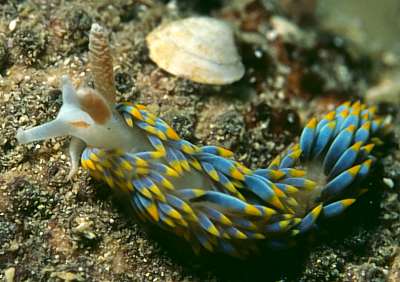
Berghia coerulescens
(Laurillard, 1830)
Order: NUDIBRANCHIA
Suborder: AEOLIDINA
Family: Aeolidiidae
DISTRIBUTION
Mediterranean and adjacent Atlantic coasts.
PHOTO
Celce village, near Krk, Croatia. 10 August 2003. Photo: Duncan v Vliet
The body colour is white, while the cerata are light blue with a yellow tip. There can be a pair of orange marks on the head between the rhinophores and oral tentacles. The orange brown rhinophore clubs are papillate posteriorly but along the sides the papillae appear to coalesce into ridges. The foot corners are tentaculiform. They feed on sea anemones and grow to 70 mm in length. Atlantic-Mediterranean species, quite common in temperate-warm waters
References:
• Cattaneo-Vietti, R., Chemello, R. & Giannuzzi-Savelli, R. (1990). Atlas of Mediterranean Nudibranchs. La Conchiglia, Rome. 264 pages
• Tardy, J. (1962): A propos des especes de Berghia (Gasteropodes Nudibranches) des cotes de France et de leur biologie. Bulletin de l'Institut de l'Oceanographie, Monaco, 1255: 2-18.
Rudman, W.B., 2003 (October 10) Berghia coerulescens (Laurillard, 1830). [In] Sea Slug Forum. Australian Museum, Sydney. Available from http://www.seaslugforum.net/find/bergcoer
Related messages
Berghia coerulescens and egg ribbon?
October 14, 2008
From: Sylvie Grall

Concerning message #21858:
Dear Bill,
Could these eggs be the eggs of Berghia coerulescens? There were 2 specimens under a stone together with these eggs so I assumed they were related. But they look big to me. This shallow place has a lot of small anemones Aiptasia diaphana on the rocks, that could be their food.
I have been looking for this species for a long time. I'll try to find more information on their food habits.
Locality: La Madrague beach - Rosas, 1 m, Spain, Mediterranean sea, June 2007, Rocky water edge. Length: 2 cm. Photographer: Sylvie Grall.
Thank you,
Sylvie
sylvgrall@orange.fr
Grall, S., 2008 (Oct 14) Berghia coerulescens and egg ribbon?. [Message in] Sea Slug Forum. Australian Museum, Sydney. Available from http://www.seaslugforum.net/find/21935
Dear Sylvie
Thanks for this record. I suspect this is the egg ribbon of Berghia coerulescens but I can't find an illustration. Tardy (19620 described it as 'ruban festonné' which I translate as 'ribbon scalloped' which could describe your egg ribbon. He also says the veliger larvae are quite large [250µm in diameter] which fits your large eggs as well. If anyone has a photo or can confirm these are the eggs of Berghia coerulescens, please let us know. Tardy also records it feeding on a species of Aiptasia, which follows the normal food choice of this family of aeolids [Aeolidiidae] which almost all feed on sea anemones.
-
Tardy, J. (1962) A propos des espèces de Berghia (Gastéropodes Nudibranches) des côtes de France et de leur biologie. Bulletin de l'Institut de l'Océanographie, Monaco, 1255: 2-18.
Best wishes,
Bill Rudman
Re: Berghia coerulescens from French Mediterranean
September 5, 2008
From: Dominique Horst

Concerning message #10617:
Hi Bill,
I think this is Berghia coerulescens with its very particular rhinophores.
We've met this species only at the same site on a very precise location.
But it's the first time we had time for a photo sequence.
Locality: Cannes, 24 m, France, Mediterranean sea, 31 August 2008. Length: 22 mm. Photographer: Dominique Horst.
Kind regards,
Dominique
dominique.horst@wanadoo.fr



Dear Dom,
Thanks for these great shots of the rhinophores. In the early scientific literature the rhinophores have been described by some as papillate and by others as lamellate. It looks like they are better described as having lamellae which break up posteriorly into irregular papillae. The reason this is important is that it helps decide whether Berghia coerulescens is linked to a group of species with papillate rhinophores other another group with lamellate rhinophores.
Best wishes,
Bill Rudman
Re: Is this a juvenile Berghia coerulescens?
May 2, 2008
From: Miquel Pontes
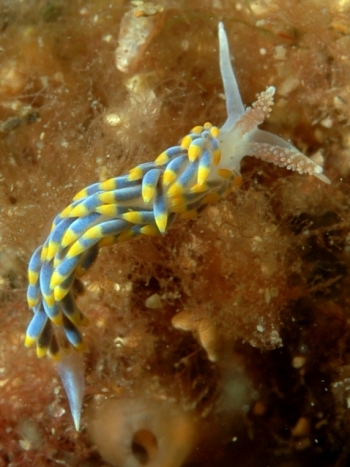

Concerning message #2450:
Dear Bill,
Besides being a passionate diver and nudibranch photographer, I do also enjoy investigating the ethymology of the nudibranch names.
In one of our last dives (April 19th, 2008) we came across this nice Berghia coerulescens in about 8 meters of water, at Illa Mateua (L'Escala, Costa Brava, Spain). Water temperature was about 13ºC.
Locality: Illa Mateua, 8 m., L'Escala, Costa Brava, Girona, Spain, Mediterranean Sea, 19 April 2008, Rocky bottom covered with photophile algae. Length: 25 mm.. Photographer: Miquel Pontes.
What draw my attention was the fact that this nudibranch's species name is "coerulescens" while a very similar "Cuthona" nudibranch receives the species name "caerulea ".
Being used a Latin word for describing one of the main animal traits (that of blue color in cerata, as "coerulea" means "blue") I found it "funny" that two slugs so close in appearance have a different species name.
Theoretically "coerulea" is the proper Latin word for describing "blue" while "caerulea" is often used, but it is not widely accepted. To my understanding species names should be "Berghia coerulescens" and "Cuthona coerulea ". This is not the case in the Forum nor in the bibliography.
I know, I know, it's just a letter, but in science there should be a reason for every fact, so I'm intrigued by this case.
For those wondering how these strange Latin names are spelled, here it is an interesting link: http://www.saltspring.com/capewest/pron.htm
Best regards,
Miquel
info@marenostrum.org
miquelpontes@gmail.com
Pontes, Miquel, 2008 (May 2) Re: Is this a juvenile Berghia coerulescens?. [Message in] Sea Slug Forum. Australian Museum, Sydney. Available from http://www.seaslugforum.net/find/21557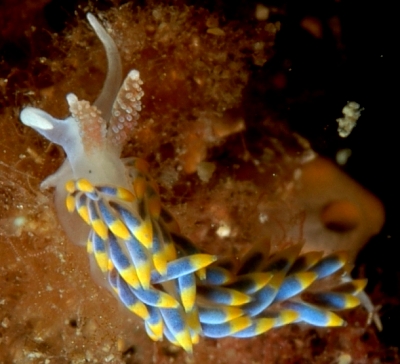
Dear Miquel,
Thanks for the nice photos which show the rhinophores very clearly.
Concerning the variations in Latinised words I guess we can blame human individuality rather than human failings. These days IT people want to force us into complete conformity so that database searching becomes 'faultless'. I some times miss the days when I could scan down a list and my brain would pick up the variations and mispellings which computers still can't do easily.
Another interesting site is Botanical Epithets which lists lots of plant species names with meanings and the latin root which is useful in changing endings to match gender etc. I have listed below some of the words for blue or deep blue and I am sure there are many more. You can see there that the oe - ae vowel was transcribed in both ways. However in Zoological Nomenclature the spelling used by the original author is the valid spelling except in a few special cases.
caelestinus, caelestini, caelestinum, caelestis, caelestis, caeleste, caelicolor, caelicolores, coelestinus, coelestina, coelestinum, coelestis, coelestis, coeleste, coeruleus, coerulea, coeruleum, caeruleus, caerulea, caeruleum.
The site you mention, on pronunciation, reminds me of many funny occasions I have witnessed at scientific gatherings, where everybody pronounces scientific names with their own unique pronuciations, sometimes developed from school latin, but usually from the way their own language pronounces vowels and consonants. It can be quite confusing for a while. I often get told by amateur helpers that they are embarrassed to use scientific names because their pronunciation is silly. I just tell them that when 10 malacologists meet there will up to 12 different pronunciations for the same name.
Best wishes,
Bill Rudman
Berghia coerulescens from Croatia
October 10, 2003
From: Duncan v Vliet

Dear Bill
Thanks for your comments on Tethys fimbria. Can you help me with this photo please? It is from the same place.
Locality: Celce village, near Krk. Croatia. 10 August 2003. Photo: Duncan v Vliet
Greetings,
Duncan
duncan@onderwaterwereld.net
v Vliet, D., 2003 (Oct 10) Berghia coerulescens from Croatia. [Message in] Sea Slug Forum. Australian Museum, Sydney. Available from http://www.seaslugforum.net/find/11197
Dear Duncan,
This is Berghia coerulescens. There are a number of species of aeolid nudibranch with this brilliant yellow and blue colouration. One other common European - Mediterranean species with this colour pattern is Cuthona caerulea but one obvious difference is that that species has smooth rhinophores while your animal has distinctive wrinkling and papillae.
Best wishes
Bill Rudman
Berghia coerulescens from French Mediterranean
August 3, 2003
From: Marina Poddubetskaia

Dear Bill,
I see that you have only one photo of Berghia coerulescens on the Forum. So, here are some more photos of this species.
Date: July 12, 2003
Location: Cerbere, France, Mediterranean coast
Site: Les Chambres
Depth: 12m
Size: 15mm
Photos: Marina Poddubetskaia - Nembro website
Cordially,
Marina.
nembro@nembro.info
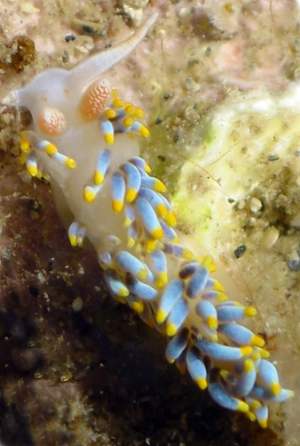
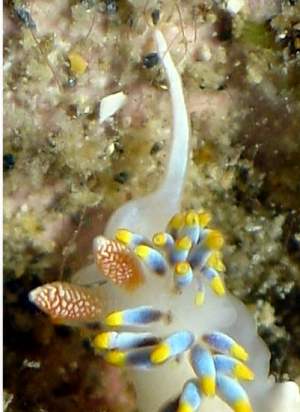
Thanks Marina,
These make a very valuable addition to the Forum.
Best wishes,
Bill Rudman
Is this a juvenile Berghia coerulescens?
May 26, 2000
From: Erwin Koehler
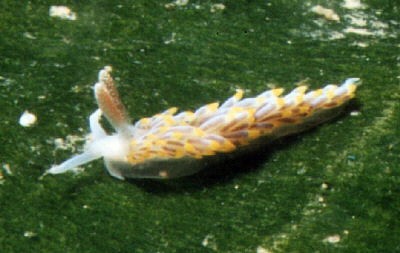
Dear Bill,
I am back from Spain and here is the first photo.
I think it might be a juvenile Berghia coerulescens. It was found at 27m depth upon Udotea petiolata and was 12mm long.
divesite "Cabo Norfeo", Cala Joncols, Spain, May 02, 2000.
Erwin
Medslugs.Koehler@t-online.de
Koehler, E., 2000 (May 26) Is this a juvenile Berghia coerulescens?. [Message in] Sea Slug Forum. Australian Museum, Sydney. Available from http://www.seaslugforum.net/find/2450Dear Erwin,
From its colour and the papillate rhinophores it certainly looks like Berghia coerulescens.
Best wishes,
Bill Rudman.
